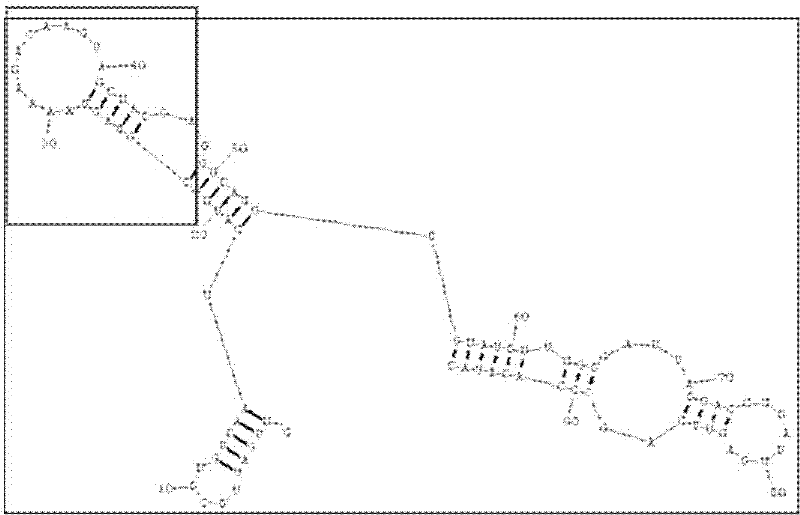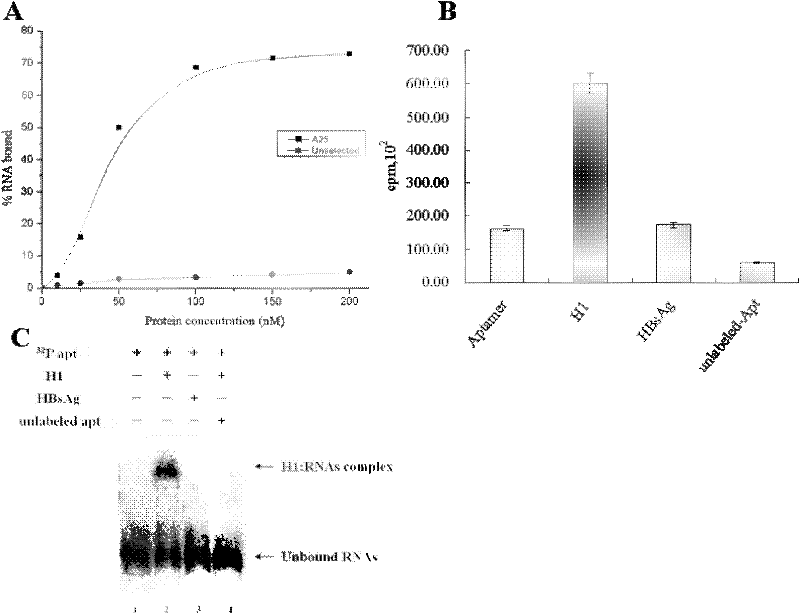RNA aptamer of targeting hepatocyte and nucleotide sequence thereof
A nucleotide sequence and aptamer technology, applied in the field of diagnosis and treatment of liver diseases, can solve problems such as lack of specific targeting of liver cells, and achieve the effect of simple method and low cost
- Summary
- Abstract
- Description
- Claims
- Application Information
AI Technical Summary
Problems solved by technology
Method used
Image
Examples
Embodiment 1
[0017] Example 1: SELEX screening of H1 protein specifically binding to RNA aptamer
[0018] SELEX screening process such as figure 1 As shown, chemically synthesized initial oligonucleotide random library and primers, the sequence is as follows: 5'-TTAATACGACTCACTATAGTTGATTGCGTGTCAATCATGG-25N-GGTCATGTGTATGTTGGGGATTAGGACCTGATTGAGTTCAGCCCACATAC-3' (T7 promoter sequence is underlined, 25N represents 25 random nucleotides);
[0019] Primer 1: 5′-TTAATACGACTCACTATAGTTGATTGCGTGTCAATC-3′,
[0020] Primer 2: 5'-GTATGTGGGCTGAACTCAAT-3'. The single-stranded DNA library is amplified into double-stranded DNA, and the product is subjected to 2% agarose gel electrophoresis and then gel-cut to recover and purify; the recovered double-stranded DNA is used as a template to transcribe a single-stranded RNA random library in vitro, and the transcript is purified by PAGE . 68 μg RNA library was screened through nitrocellulose membrane to remove membrane-bound RNA molecules, then incubated wit...
Embodiment 2
[0021] Example 2: Secondary structure analysis of RNA aptamers
[0022] The library obtained in the 12th round of screening was cloned into the pMD19-T vector, transformed into Escherichia coli DH5α, and 48 clones were randomly selected and sequenced. Obtain the sequence information of the screened aptamers, predict the RNA secondary structure of all sequencing clones through the structure prediction software RNA Structure Program, and obtain an aptamer that can form a special stem-loop in the random sequence region (23-47nt) structure, such as figure 2 shown.
Embodiment 3
[0023] Example 3: Obtaining specific high-affinity H1 protein binding to suitable gametes
[0024] Take 1 μg of the RNA aptamers with the above secondary structures, digest them with calf intestinal alkaline phosphatase (CIP) at 37°C for 1 h, purify and recover the dephosphorylated RNA; label [γ- 32 P]ATP at the end of dephosphorylated RNA molecules. 10nmol of radioactively labeled RNA aptamers were incubated with different concentrations (10-200nM) of H1 protein at 37°C for 40min. The reaction solutions of each group were filtered through a nitrocellulose membrane, washed, dried, and measured by a liquid scintillation counter. The amount of radioactivity remaining on the filter membrane was measured twice in parallel on the same sample. The dissociation constant between each aptamer and H1 protein was calculated, and the aptamer with the highest affinity was obtained, which was named H1-A25. 32 P-labeled H1-A25 was incubated with H1 protein, irrelevant protein HBsAg, and ex...
PUM
 Login to View More
Login to View More Abstract
Description
Claims
Application Information
 Login to View More
Login to View More - R&D
- Intellectual Property
- Life Sciences
- Materials
- Tech Scout
- Unparalleled Data Quality
- Higher Quality Content
- 60% Fewer Hallucinations
Browse by: Latest US Patents, China's latest patents, Technical Efficacy Thesaurus, Application Domain, Technology Topic, Popular Technical Reports.
© 2025 PatSnap. All rights reserved.Legal|Privacy policy|Modern Slavery Act Transparency Statement|Sitemap|About US| Contact US: help@patsnap.com



